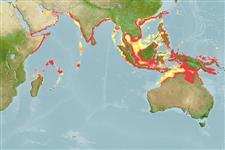Issue
IN genus Rhinobatos in Eschmeyer (CofF ver. November 2013: Ref. 94485).
Environment: milieu / climate zone / depth range / distribution range
Ecology
Marine; demersal; depth range 0 - 119 m (Ref. 9909). Subtropical; 29°N - 18°S, 49°E - 156°E
Northern Indian Ocean; Persian Gulf to Myanmar.
Size / Weight / Age
Maturity: Lm ? range ? - ? cm
Max length : 280 cm SL male/unsexed; (Ref. 30573)
Ranges from the intertidal to offshore continental shelves down to 119 m (Ref. 9909). A carnivorous fish that feeds on large shellfishes (Ref. 58784). Ovoviviparous (Ref. 50449). Produces 6-10 pups a litter (Ref.114953). Biology little known (Ref. 9909). Utilized where it occurs but details lacking (Ref. 9909).
Life cycle and mating behavior
Maturity | Reproduction | Spawning | Eggs | Fecundity | Larvae
Exhibit ovoviparity (aplacental viviparity), with embryos feeding initially on yolk, then receiving additional nourishment from the mother by indirect absorption of uterine fluid enriched with mucus, fat or protein through specialised structures (Ref. 50449).
Ebert, D.A., S. Fowler and M. Dando, 2021. Sharks of the World: A complete guide. Princeton University Press, 607p. (Ref. 125614)
IUCN Red List Status (Ref. 130435: Version 2024-2)
Threat to humans
Harmless
Human uses
Fisheries: commercial
Tools
Special reports
Download XML
Internet sources
Estimates based on models
Preferred temperature (Ref.
123201): 25.2 - 29.1, mean 28.1 °C (based on 1678 cells).
Phylogenetic diversity index (Ref.
82804): PD
50 = 0.5156 [Uniqueness, from 0.5 = low to 2.0 = high].
Bayesian length-weight: a=0.00234 (0.00159 - 0.00347), b=3.02 (2.91 - 3.13), in cm total length, based on LWR estimates for this species (Ref.
93245).
Trophic level (Ref.
69278): 3.5 ±0.37 se; based on food items.
Resilience (Ref.
120179): Low, minimum population doubling time 4.5 - 14 years (Fec assumed to be <100).
Fishing Vulnerability (Ref.
59153): Very high vulnerability (90 of 100).
